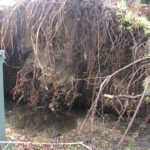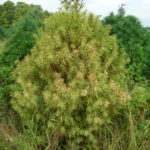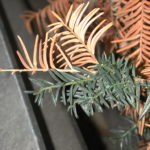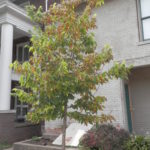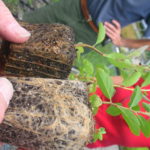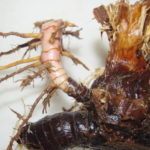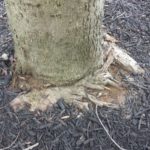“We never look deeply into the quality of a tree; we never really touch it, feel its solidity, its rough bark, and hear the sound that is part of the tree. Not the sound of wind through the leaves, not the breeze of a morning that flutters the leaves, but its own sound, the sound of the trunk and the silent sound of the roots.” Jiddu Krishnamurti
When appreciating the beauty of trees (or any plant, for that matter!), we often overlook what goes on underground—the roots. The major function of the root is to anchor the plant to the soil, and to absorb water and nutrients for the plant. Unfortunately, the roots are rarely observed in their entirety even though the structure of the root system profoundly impacts plant health above-ground. As a result, root problems are frequently under- and misdiagnosed. Until it is too late (Fig. 1).
Unusually wet weather results in poor root growth, predisposing plants to problems. Simply stated, the plant failed to develop an extensive root system because water was too easily acquired. During these periods of excessive moisture, roots may even leak, attracting opportunistic fungi and water molds that infect and rot roots. These infections may be completely asymptomatic in the aboveground portion of the plant until spring and summer rains change into summer heat, dry spells or drought. The poorly developed and/or infected roots that grew during the wet periods can no longer support the aboveground plant (stems, branches, leaves) in dry times. As the leaves and branches start to die, they produce less food (photosynthate) for the roots. As the roots starve, they are unable to provide the water needed for photosynthesis. After this process has progressed for a few weeks, vague symptoms develop and include slow(er) growth, decline in crown, smaller leaves that may or may not be chlorotic, heavier seed crops, and the simple description “It just doesn’t look good.”
As this decline progresses, secondary insects and opportunistic fungi attack these plants, and are often blamed for the overall poor health (Fig. 2). At this point, a ‘negative feedback loop’ where dying leaves fail to support dying roots can result in plant death, unless some type of equilibrium can be achieved and the loop is aborted. Plant death results in the plant not being able to take up sufficient water or nutrients to support the branch, leaf, flowers, or fruit development.
Other symptoms of root death to note include:
ABOVE GROUND
- Slower growth compared to healthy plants. Shoot length is reduced compared to healthy neighbors, or there are even scattered dead shoots (Fig. 3).
- Leaves turn yellow and wilt.
- Leaf scorch describes when the margin of leaves turn brown (Fig. 4).
- Small shoots to large side branches are dying or dead
- Cankering and dieback of shoots, branches and stem contributes to dieback and death.
- Figure 3. Evidence of decline can be seen when comparing leaf and short growth from previous year to current year.
- Figure 4. Hackberry with leaf scorch. Photo by Dr. Greg Shaner.
Whenever possible, carefully excavate roots, and wash them. Often times, this requires extensive sampling because 100% of the root area is rarely infected. Using a hand trowel and/or small shovel, remove multiple ~ 1-cup samples of that includes soil, larger woody roots and small feeder rots from at least three locations around the tree. This should be performed from at least three sides of the affected tree. Store samples in a plastic bag, preferably in a cooler with ice to keep from drying out. Samples should include areas within the dripline, by the main stem, and somewhere in between. Any suspicious areas (crown rot, mushrooms, conks, fruiting bodies) should be included in the sampling.
We regularly deploy a mason jar with a mesh screen instead of a lid to clean roots under running water while not losing root material. Examine the roots for signs of rot that include a lack of root hairs, poor root growth, or yellow, brown or blackened roots. Always make sure you know what normal roots look like when examining roots! Keep in mind that some plants, like azalea and rhododendron, have dark roots, others may be colonized by mycorrhizae or nitrogen-fixing bacteria.
BELOW GROUND
- Roots appear water-soaked, discolored (brown or black); lack of small roots. Always make sure you know what normal roots look like when examining roots (Fig. 5,6)!
- Figure 5. Comparing healthy to rotted roots.
- Figure 6. Washed roots showing evidence of rot.
Unfortunately, examining the roots for established woody plants, particularly trees and shrubs, is difficult, and may not be possible in all situations without the help of a tree care professional. After removing the soil from the base of the tree, evaluate whether any of the following problems are involved:
- Excessive mulch
- Planted too deeply or shallowly
- Significant root or root flare damage
- Stem girdling, or root girdling root (Fig 7. 17-01281 Maple_02)
- Few main roots or roots on only one side of tree or shrub
- Insect or animal feeding damage
- Root rot
- Galls
The primary causal agents of woody plant root disease are fungi like Armillaria, Thielaviopsis and Fusarium (to name but a few!), and the ‘water molds’ from the genera Phytophthora and Pythium. Although very different organisms, they are all able to survive on dead and dying tissue. Some of these fungi are opportunists, attacking those plants suffering from poor site, drought, flooding, or other abiotic disorders commonly found in the urban landscape, whereas others are virulent primary pathogens that can attack an otherwise healthy host.
A diagnosis of the root rot is necessary to develop a good management plan, including the right fungicide, good cultural controls, and what other nearby plants may be susceptible. Like many things, it is more easily said than done. Diagnosing a root rot requires capturing the infected tissue at the right time to culture out the pathogen or pathogens causing the problem.
Prevention is the best approach to managing root rots. If using plants that are known hosts for root rots (i.e., azalea, beech, pieris, rhododendron, for Phytophthora; oak for Armillaria, etc. ), avoid setting the plant up for failure. For Phytophthora susceptible plants, avoid heavy clay, poorly draining soil and low spots that collect water. For Armillaria, remove any stumps completely via grinding and avoid planting new trees in the same spot where trees have died.
Some root rots (e.g., caused by Phytophthora) are treatable, if caught and diagnosed early enough, or better still, treated prophylactically. It is possible for the plant to compartmentalize and outgrow root damage, although there are many factors that that make successful treatment of plant diseases challenging. Factors that impact successful treatment include the type of host plant, its susceptibility to the pathogen, its vigor and overall health, the site, and the type of pathogen. Remember that damage occurred over several seasons, and recovery may take just as long, even under the best of circumstances.
In some instances, saving a tree or shrub simply isn’t possible or cost effective. Often times, cutting losses involves a chainsaw. Plants can often be replaced with an identical clone of what was lost, or with something more disease resistant or even completely different, thereby avoiding future problems, and hopefully achieving a newer, healthier tree to enjoy, leaves, bark, and roots!
